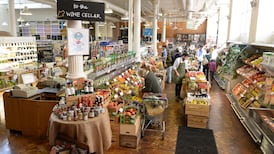Irish farmers had a very difficult year in 2023 with dairy and tillage farms experiencing steep reductions in income, according to Teagasc’s annual national farm survey published on Tuesday.
The decline was “largely due to a sharp decline in milk and cereal prices, and lower production volumes in a period of stubbornly high input prices, exacerbated by the bad weather”.
The slide in earnings from dairying and tillage follows record incomes in 2022, “illustrating yet again the highly volatile nature of farm income in both of these farm systems in Ireland”, Teagasc said.
Irish Farmers’ Association (IFA) president Francie Gorman said the findings were a stark reminder of the fragility of Irish agriculture. “Average family farm income in 2023 was less than €20,000, the lowest level in more than a decade,” he added.
READ MORE
Cattle and sheep farms saw the value of output fall with production costs remaining high, while incomes on dry stock farms in 2023 were notably lower than in 2022.
“Collectively, these lower price and production volumes had a substantial negative influence on the average farm income in Ireland,” it added. The survey is representative of almost 85,000 farms in Ireland.
Internationally, there was a sharp downturn in dairy commodity prices in 2023, which in turn affected Irish farm milk prices. Favourable production conditions for cereal crops at the global level also led to a global harvest that put downward pressure on international and Irish grain prices.
Challenging weather conditions were concentrated over the second half of the year, with high levels of rainfall having an adverse impact on tillage yields, grazing conditions and silage production. Milk production fell, as cows were dried-off early in the face of low milk margins.

Ireland’s hospitality sector: ‘The customer feels they are not getting value for money’
“Farm income levels are now at historically low levels, with an average drop of 57 per cent compared to 2022,” Mr Gorman said. “No sector fared well: tillage and dairy took the biggest hits in terms of overall drop. Sheep and livestock farmers were also heavily impacted with average suckler farmer income now the lowest on record. Across all enterprises, the pressure on farm families is proving very challenging. The incoming European Union Commission should see this as a wake-up call. Expecting food production to continue as normal under these conditions is just not sustainable.”
Further contraction in food production was inevitable unless retailers started paying a fair price for food “and national and European agricultural policy adjusts to recognise that these farm income levels are not viable”, he said.
Dairy system production costs, which rose by more than 30 per cent to their highest level in 2022, remained at that record level in 2023. While the dairy cow population continued to increase in 2023, milk output volume fell by 4 per cent in the face of low profitability and challenging production conditions at the back end of last year.
It resulted in an average dairy farm income of just under €49,500 in 2023; a fall of 69 per cent or above €105,000, compared to 2022.
In the cattle rearing system, comprising of farms mainly specialised in suckler beef production, the value of output increased by 6 per cent in 2023, mainly due to higher cattle prices. While some cost items such as fertiliser fell in price during 2023, the decline came too late in the growing season to bring about significant cost savings.
- Sign up for push alerts and have the best news, analysis and comment delivered directly to your phone
- Join The Irish Times on WhatsApp and stay up to date
- Listen to our Inside Politics podcast for the best political chat and analysis












